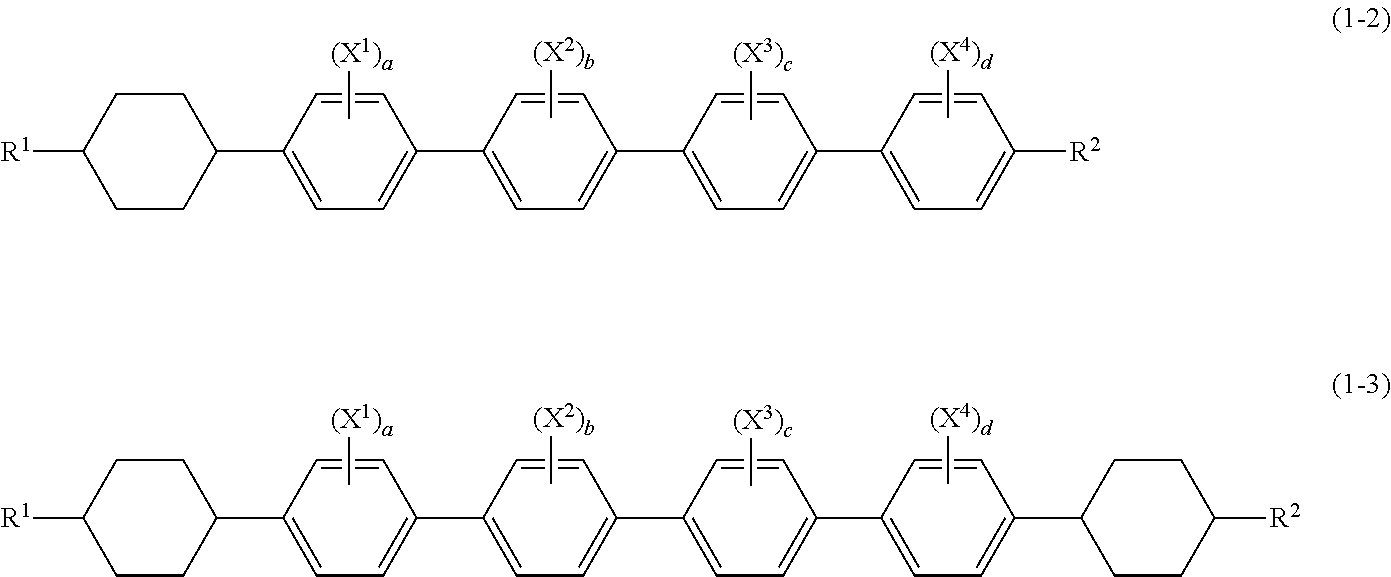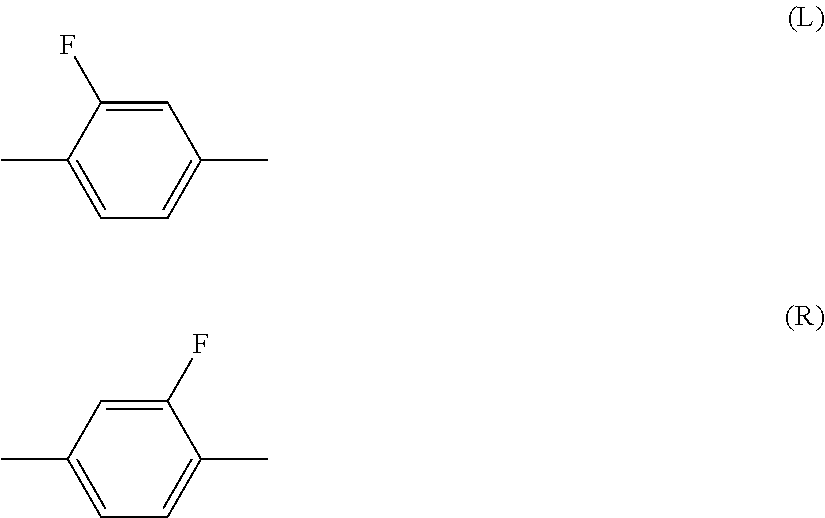Liquid crystal composition and liquid crystal display device
a liquid crystal display and composition technology, applied in the field of liquid crystal compositions and liquid crystal display devices, can solve the problems of large contrast ratio of devices, small electric power consumption, and device service life, and achieve the effects of increasing dielectric anisotropy, reducing the minimum temperature, and high stability to ultraviolet ligh
- Summary
- Abstract
- Description
- Claims
- Application Information
AI Technical Summary
Benefits of technology
Problems solved by technology
Method used
Image
Examples
example 1
Synthesis of Compound (1-2-1)
[0138]
[0139]3-Fluoro-4-iodo-4′-(4-pentylcyclohexyl)-1,1′-biphenyl (22.08 g, 49.03 mmol), (4′-ethyl-[1,1′-biphenyl]-4-yl)boronic acid (11.64 g, 51.49 mmol), 5%-palladium on carbon (50 wt % H2O, 0.66 g), potassium carbonate (10.17 g, 73.55 mmol) and tetrabutylammonium bromide (TBAB) (3.95 g, 12.26 mmol) were refluxed for 3 hours in a mixed solvent of toluene (300 mL), ethanol (50 mL) and water (100 mL). The reaction mixture was filtered, and the filtrate was concentrated. A precipitated solid was obtained by filtration, and washed with water. The solid was purified by silica gel chromatography (effluent: THF), and further recrystallization from toluene to give compound (1-2-1) (17.38 g; yield 69.5%).
[0140]1H-NMR (δ ppm; CDCl3): 7.70-7.65 (m, 4H), 7.60-7.52 (m, 5H), 7.47-7.44 (m, 1H), 7.42-7.38 (m, 1H), 7.33-7.29 (m, 4H), 2.71 (q, 2H), 2.53 (tt, 1H), 1.97-1.87 (m, 4H), 1.55-1.45 (m, 2H), 1.38-1.20 (m, 12H), 1.13-1.03 (m, 2H), 0.91 (t, 3H).
[0141]Characterist...
example 2
Synthesis of Compound (1-2-2)
[0144]
[0145]3-Fluoro-4-iodo-4′-(4-pentylcyclohexyl)-1,1′-biphenyl (10.0 g, 22.20 mmol), (4′-ethyl-2-fluoro-[1,1′-biphenyl]-4-yl)boronic acid (6.50 g, 26.64 mmol), 5%-palladium on carbon (50 wt % H2O, 0.50 g), potassium carbonate (6.14 g, 44.41 mmol) and tetrabutylammonium bromide (TBAB) (1.79 g, 5.55 mmol) were refluxed for 3 hours in a mixed solvent of toluene (50 mL), ethanol (50 mL) and water (20 mL). The reaction mixture was filtered, and the filtrate was concentrated. A precipitated solid was obtained by filtration, and washed with water. The solid was purified by silica gel chromatography (effluent: THF), and further recrystallization from a toluene-Solmix (2:1 in a volume ratio) to give compound (1-2-2) (5.22 g; yield 44.8%).
[0146]1H-NMR (δ ppm; CDCl3): 7.58-7.50 (m, 6H), 7.48-7.38 (m, 4H), 7.34-7.28 (m, 4H), 2.72 (q, 2H), 2.52 (tt, 1H), 1.98-1.86 (m, 4H), 1.56-1.45 (m, 2H), 1.38-1.20 (m, 12H), 1.13-1.02 (m, 2H), 0.91 (t, 3H).
[0147]A composition w...
example 3
Synthesis of Compound (1-3-1)
[0149]
[0150]3-Fluoro-4-iodo-4′-(4-pentylcyclohexyl)-1,1′-biphenyl (21.0 g, 46.63 mmol), (3-fluoro-4′-(4-pentylcyclohexyl)-[1,1′-biphenyl]-4-yl)boronic acid (20.6 g, 55.95 mmol), 5%-palladium on carbon (50 wt % H2O, 1.05 g), potassium carbonate (12.9 g, 93.34 mmol) and tetrabutylammonium bromide (TBAB) (3.76 g, 11.7 mmol) were refluxed for 3 hours in a mixed solvent of toluene (300 mL), ethanol (50 mL) and water (100 mL). The reaction mixture was filtered, and the filtrate was concentrated. A precipitated solid was obtained by filtration, and washed with water. The solid was purified by silica gel chromatography (effluent: THF), and further recrystallization from toluene to give compound (1-3-1) (22.51 g; yield 74.6%).
[0151]1H-NMR (δ ppm; CDCl3): 7.58-7.54 (m, 4H), 7.51-7.44 (m, 4H), 7.43-7.38 (m, 2H), 7.34-7.29 (m, 4H), 2.53 (tt, 2H), 1.98-1.86 (m, 8H), 1.57-1.45 (m, 4H), 1.38-1.20 (m, 18H), 1.13-1.02 (m, 4H), 0.91 (t, 6H).
[0152]A composition was prepare...
PUM
| Property | Measurement | Unit |
|---|---|---|
| temperature | aaaaa | aaaaa |
| temperature | aaaaa | aaaaa |
| response time | aaaaa | aaaaa |
Abstract
Description
Claims
Application Information
 Login to View More
Login to View More - R&D
- Intellectual Property
- Life Sciences
- Materials
- Tech Scout
- Unparalleled Data Quality
- Higher Quality Content
- 60% Fewer Hallucinations
Browse by: Latest US Patents, China's latest patents, Technical Efficacy Thesaurus, Application Domain, Technology Topic, Popular Technical Reports.
© 2025 PatSnap. All rights reserved.Legal|Privacy policy|Modern Slavery Act Transparency Statement|Sitemap|About US| Contact US: help@patsnap.com



